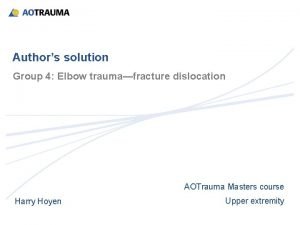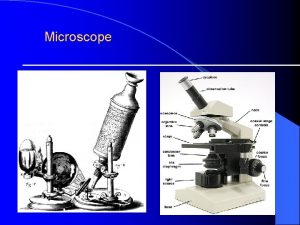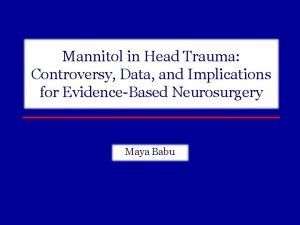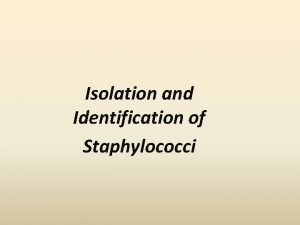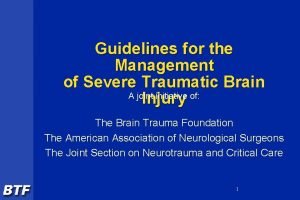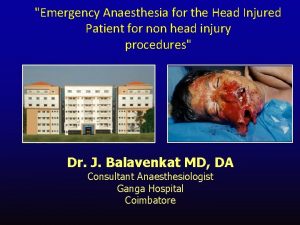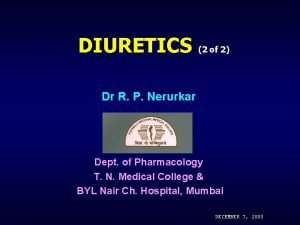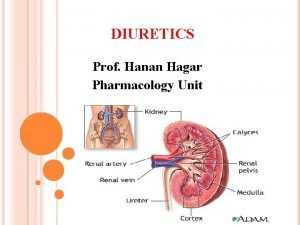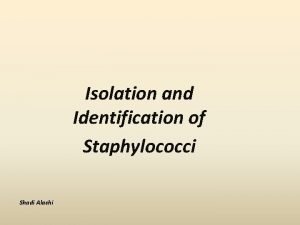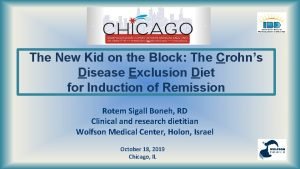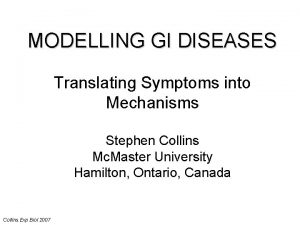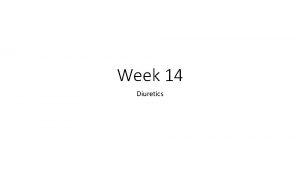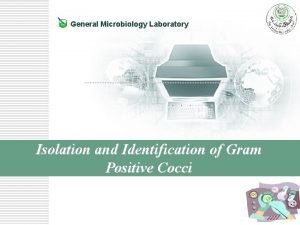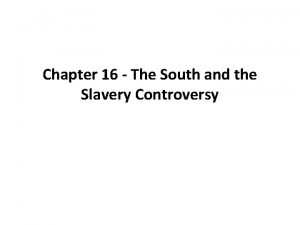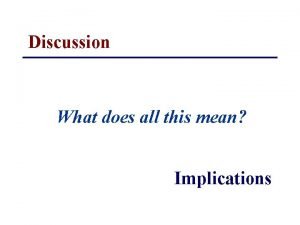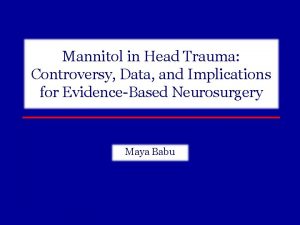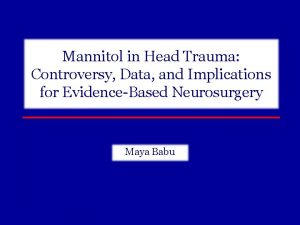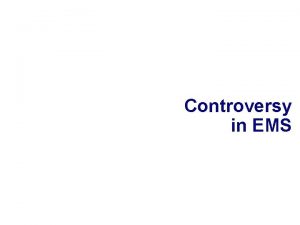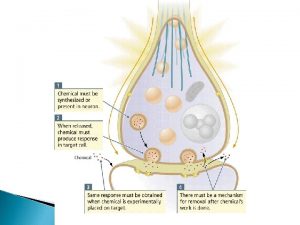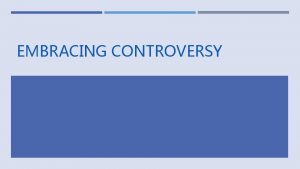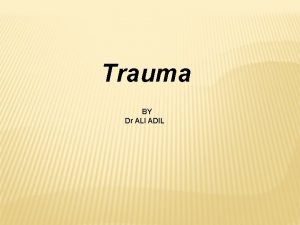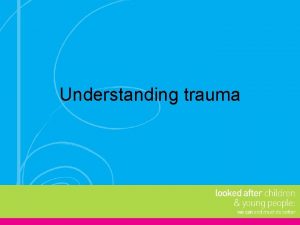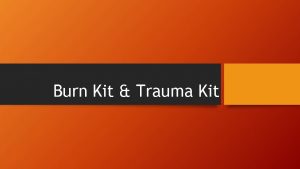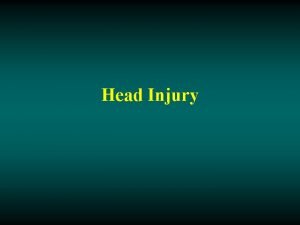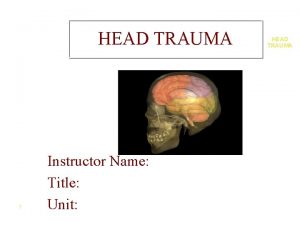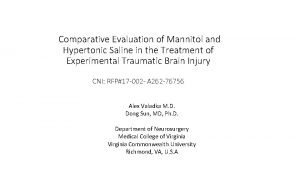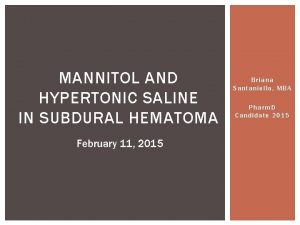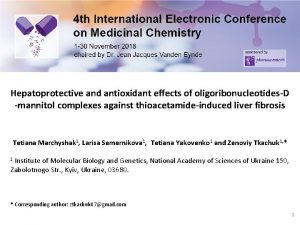Mannitol in Head Trauma Controversy Data and Implications




























- Slides: 28

Mannitol in Head Trauma: Controversy, Data, and Implications for Evidence-Based Neurosurgery Maya Babu

Summary Mannitol & Head Trauma Controversy Four Papers Implications for Evidence-Based Neurosurgery

Head Trauma & Mannitol • 1. 4 million people in the US sustain traumatic brain injury annually (Langlois, 2007) – 235, 000 hospitalized; 50, 000 die • 2 types of brain insults – Primary insult: Due to trauma; irreversible – Secondary insult: Worsening ischemia due to intracranial pressure (ICP), edema, hypoxia • Mannitol as a treatment following head trauma first described in the literature in 1961 (Wise and Chater) • Mannitol is an osmotic diuretic (C 6 H 8(OH)6) • 83% of critical care centers in the US use mannitol in >50% of their severely head-injured patients (Ghajar, 1995) • Used as a treatment in moribund trauma patients

Controversy • Three papers by Dr. Julio Cruz, et al: – – – Cruz J, Minoja G, Okuchi K. Improving clinical outcomes from acute subdural hematomas with emergency preoperative administration of high doses of mannitol: a randomized trial. Neurosurgery 2001; 49(4): 864 -71. Cruz J, Minoja G, Okuchi K. Major clinical and physiological benefits of early high doses of mannitol for intraparenchymal temporal lobe hemorrhages with abnormal pupilary widening. Neurosurgery 2002; 51(3): 628 -38. Cruz J, Minoja G, Okuchi K, Facco E. Successful use of the new high-dose mannitol treatment in patients with Glasgow Coma Scores of 3 and bilateral abnormal pupillary widening: a randomized trial. Journal of Neurosurgery 2004; 100(3): 376 -83. • Co-authors unaware of the paper; had phone conversations with Cruz • No evidence of patient enrollment • No confirmation of Dr. Cruz’s affiliation • Dr. Julio Cruz committed suicide in 2005 • (2006) Cochrane Systematic Review: Reversed its position on high-dose mannitol

Is mannitol dangerous…. or just not that effective?

Isovolume hypertonic solutes in the treatment of refractory posttraumatic intracranial hypertension Vialet et al, Critical Care Medicine (2003)

Vialet et al: Question and Methods Question • How effective is mannitol compared to hypertonic saline solution (HSS) in refractory intracranial hypertension (ICH)? Methods • • • Prospective, Randomized Trial at a French Trauma Center 20 consecutive patients with head trauma; GCS<8 All patients received an ICP monitor Interventions 2 m. L/kg of (1) 20% Mannitol or (2) 7. 5% HSS Aim: ICP <25 mm Hg or increase CPP > 70 mm Hg Outcome measures: (1) Number and duration of episodes of ICH daily (2) Rate of failure for each treatment • Patients were monitored for 7 days

Vialet et al: Results and Conclusions Results • Mean number of infusions (n. s. ) – Mannitol=3. 7 vs. HSS = 3. 3 infusions • Mean number of ICH episodes daily (p<. 01) – Mannitol = 13. 3 vs. HSS = 6. 9 episodes • Rate of clinical failure (p<. 01) – Mannitol = 7 vs HSS = 1 patients Conclusion • Giving patients a higher osmotic load with HSS is more effective in treating ICH than mannitol Limitations • Small sample size • One-center • Type of solute or dosing?

Comparison of mannitol regimens in patients with severe head injury undergoing intracranial monitoring Smith et al, Journal of Neurosurgery (1986)

Smith et al: Question and Methods Question • Does changing mannitol dose depending on ICP monitoring affect outcomes? Methods • Prospective, randomized study • (1980 -1982) Every head injury patient presenting to North Carolina Baptist Hospital: (1) within 6 h of injury (2) with a GCS ≤ 8 for 6 h • Exclusion criterion: Gun-shot wounds • n =80 (80% male, mean age=27) • All patients had ICP monitors and were intubated • Random assignment to: • Group I: Mannitol therapy based on ICP monitoring – ICP>25 mm Hg, a 250 m. L bolus – Uncontrollable ICP: 100 m. L boluses (up to 1. 5 g/kg*hr) • Group II: Mannitol therapy based on protocol – 250 m. L bolus +. 25 g/kg every 2 h – Neurological deterioration: . 75 g/kg bolus and CT

Smith et al: Results • Rates of mortality (n. s. ): • Group I: 35% and II: 42. 5% • Mean highest ICP for survivors (p<. 05): • Group I: 35. 2 mm Hg and Group II: 29. 7 mm Hg • Mean highest ICP for non-survivors (p<. 001): • Group I: 46. 2 mm Hg and Group II: 40. 7 mm Hg

Smith et al: Conclusions and Limitations Conclusions • ICP guided mannitol administration does not influence mortality Limitations • Threshold of 25 mm Hg ICP before mannitol bolus may be too high • Mortality decreased from 46% to 28% after treating at 15 mm Hg (Saul & Ducker, 1982) • Some influence of cross-over effects from Group II

Out-of-hospital administration of mannitol does not change systolic blood pressure Sayre et al, Academic Emergency Medicine (1996)

Sayre et al: Question and Methods Question • Does out-of-hospital administration of mannitol affect systolic blood pressure adversely in a head trauma patient? Methods • Prospective, randomized, double-blind placebo controlled trial • Patients transported via university-based medical helicopter to a Level I Trauma Center • 1991 -1992: Intubated head trauma victims with a GCS<12 evaluated within 6 h of injury • Exclusions: (1) <18 (2) already received mannitol/other diuretic (3) women < 50 years old (4) receiving CPR • n=41 • Interventions: (1) 5 m. L/kg of. 9% saline (2) 5 m. L/kg 20% Mannitol • Primary endpoint: Change in systolic blood pressure over 2 h

Sayre et al: Results • Mortality (n. s. ): – Mannitol (25%) vs. Control (14%) • Mean systolic BP (p<. 01): – Mannitol (116 mm Hg) vs. Control (142 mm. Hg) • Urine output (p<. 001): – Mannitol (1351 m. L) vs. Control (634 m. L) • Serum Na+ on hospital arrival (p<. 00001): – Mannitol (130. 6) vs. Placebo ( 139. 1) • Blinded physician’s guess as to the intervention: – Resident: Correct in 11 of 13 cases – Investigator: Correct in 13 of 14 cases

Sayre et al: Conclusions and Limitations Conclusion • Mannitol administered outside the hospital in this sample of patients did not lead to permanent morbidity Limitations • Diastolic blood pressure more sensitive than systolic • Included blunt and penetrating head trauma • Not all outcomes seemingly positive

The University of Toronto Head Injury Treatment Study: A Prospective, Randomized Comparison of Pentobarbital and Mannitol Schwartz et al, The Canadian Journal of Neurological Sciences (1984)

Schwartz et al: Question and Methods Question • How does treatment of ICH due to head trauma with mannitol compare to pentobarbital? Methods • (1980 -1982): Prospective, Randomized Trial • Patients with elevated ICP (≥ 25 mm Hg) & GCS ≤ 7 • Some patients were randomized after hematoma evacuation; all patients received an ICP monitor • N=59 (80% male) • Interventions to maintain ICP < 20 mm Hg • (1) 20% Mannitol 1 g/kg; 350 m. L as needed within serum osmolality of 320 m. Os/L • (2) Pentobarbital bolus up to 10 mg/kg; continuous infusion of. 5 -3 mg/kg/hr provided that CPP >50 mm Hg • Cross-over after treatment failure occurred

Schwartz et al: Results and Conclusions Results • Mortality rates for Evacuated Hematoma Patients (n. s. ): – Pentobarbital: 40% and Mannitol: 43% • Mortality rates for Patients without Hematoma (p<. 05): – Pentobarbital: 77% and Mannitol: 41% • Twice as many pentobarbital patients had treatment failure (p<. 0001) Conclusion • Pentobarbital is no better than mannitol for the treatment of ICH, and may in fact be harmful Limitations • Hematoma removal and intracranial hypertension • May be evaluating CPP

What do these papers tell us? Study Intervention Mortality, Relative Risk (95% CI) Schwartz et al, 1984 Mannitol vs. Phenobarbital . 85 (. 52 -1. 38) Vialet et al, 2003 Manitol vs. HSS 1. 25 (. 47 -3. 33) Smith et al, 1986 ICP-guided vs. Protocol . 83 (. 47 -1. 46) Sayre et al, 1996 Mannitol vs. Saline 1. 75 (. 48 -6. 38) Dosing, Timing, and Appropriateness of Mannitol are in Doubt

Guidelines from AANS and CNS • Guidelines for the management of severe traumatic brain injury (Level II/III): – Mannitol is effective for control of raised intracranial pressure (ICP) at doses of 0. 25 g/kg to 1 g/kg body weight – Arterial hypotension (systolic blood pressure <90 mm Hg) should be avoided – Restrict mannitol use prior to ICP monitoring to patients with signs of transtentorial herniation or progressive neurological deterioration not attributable to extracranial causes Brain Trauma Foundation, American Association of Neurological Surgeons, Congress of Neurological Surgeons. Guidelines for the management of severe traumatic brain injury. Hyperosmolar therapy. J Neurotrauma 2007; 24(Suppl 1): S 14 -S 20.

Future Directions • Mannitol versus other solutions – More effective infusions with a higher osmotic load? • Potential pitfalls of mannitol (Kaufmann & Cardoso, 1992) • Research in trauma settings – Challenging to limit the influence of intervention crossover

Mannitol Controversy: Conclusions • Evidence-based neurosurgery: an analytic approach • Health reform shaped by “evidence-based medicine” – Stimulus included $1. 1 B for Comparative Effectiveness Research – Food & Drug Administration approvals – Reimbursement guidance 1 (1) Dhruva et al, New England Journal of Medicine, 2009

Evidence-Based Medicine "Half of what you'll learn in medical school will be shown to be either dead wrong or out of date within five years of your graduation; the trouble is that nobody can tell you which half -- so the most important thing to learn is how to learn on your own…" -Dr. David Sackett, evidence-based medicine pioneer

“Human beings are not uniform in their biology. Rather than rigidity, flexibility is appropriate in applying evidence from clinical trials. A good doctor exercises sound clinical judgment by consulting expert guidelines and assessing ongoing research…. but then decides what is quality care for the individual patient. And what is best sometimes deviates from the norms. ” -Jerome Groopman & Pamela Hartzband, Wall Street Journal, 2009

Acknowledgements • Dr. Clark Chen

Thank you!

References • • • • Brain Trauma Foundation, American Association of Neurological Surgeons, Congress of Neurological Surgeons. Guidelines for the management of severe traumatic brain injury. Hyperosmolar therapy. J Neurotrauma 2007; 24(Suppl 1): S 14 -S 20. Ghajar J, Hariri RJ, Narayan RK, et al. Survey of critical caremanagement of comatose, head-injured patients in the United States. Critical Care Medicine 1995; 23(3): 560– 7. Wise BL, Chater N: Effect of mannitol on cerebrospinal fluid pressure: The actions of hypertonic mannitol solutions and of urea compared. Arch Neurol 4: 200 -202, 1961. Kaufmann AM, Cardoso ER. Aggravation of vasogenic cerebral edema by multiple-dose mannitol. J Neurosurg. 1992 Oct; 77(4): 584 -9 Vialet R, Albanese J, Thomachot L, Antonini F, Bourgouin A, Alliez B, et al. Isovolume hypertonic solutes (sodium chloride or mannitol) in the treatment of refractory posttraumatic intracranial hypertension: 2 m. L/kg 7. 5% saline is more effective than 2 m. L/kg 20% mannitol. Critical. Care. Medicine 2003; 31(6): 1683– 7. Smith HP, Kelly DL Jr, Mc. Whorter JM, et al. Comparison of mannitol egimens in patients with severe head injury undergoing intracranial monitoring. Journal of Neurosurgery 1986; 65(6): 820– 4. Sayre MR, Daily SW, Stern SA, Storer DL, van Loveren HR, Hurst JD. Out-of-hospital administration ofmannitol does not change systolic blood pressure. Academic Emergency Medicine 1996; 3(9): 840– 8. Schwartz ML, Tator CH, Rowed DW, Reid SR, Meguro K, Andrews DF. The University of Toronto head injury treatment study: a prospective, randomized comparison of pentobarbital and mannitol. Cruz J, Minoja G, Okuchi K. Improving clinical outcomes from acute subdural hematomas with emergency preoperative administration of high doses of mannitol: a randomized trial. Neurosurgery 2001; 49(4): 864 -71. Cruz J, Minoja G, Okuchi K. Major clinical and physiological benefits of early high doses of mannitol for intraparenchymal temporal lobe hemorrhages with abnormal pupilary widening. Neurosurgery 2002; 51(3): 628 -38. Cruz J, Minoja G, Okuchi K, Facco E. Successful use of the new high-dose mannitol treatment in patients with Glasgow Coma Scores of 3 and bilateral abnormal pupillary widening: a randomized trial. Journal of Neurosurgery 2004; 100(3): 376 -83. Wakai A, Roberts I, Schierhout G. Mannitol for acute traumatic brain injury. Cochrane Database Syst Rev. 2005 Oct 19; (4): CD 001049. Roberts I, Smith R, Evans S. Doubts over head injury studies. BMJ 2007; 334: 392 -394,
 Emt chapter 24 trauma overview
Emt chapter 24 trauma overview Head trauma classification
Head trauma classification Enterobacter aerogenes gram positive or negative
Enterobacter aerogenes gram positive or negative Mannitol for icp
Mannitol for icp Staphylococcus saprophyticus hemolysis on blood agar
Staphylococcus saprophyticus hemolysis on blood agar Indication of mannitol
Indication of mannitol Indication of mannitol
Indication of mannitol Agar
Agar Mannitol 10%
Mannitol 10% Bumetanide vs furosemide
Bumetanide vs furosemide Mannitol infus
Mannitol infus Diuretic side effects
Diuretic side effects Mannitol salt agar
Mannitol salt agar Cded recipes
Cded recipes Lactulose mannitol
Lactulose mannitol Mannitol mechanism of action
Mannitol mechanism of action Nurses responsibility of mannitol
Nurses responsibility of mannitol Catalase test
Catalase test Blood agar
Blood agar Manitol mechanism of action
Manitol mechanism of action Dividing head formula
Dividing head formula Suction lift
Suction lift Position paper importance
Position paper importance Without controversy great is the mystery of godliness
Without controversy great is the mystery of godliness Chapter 16 the south and the slavery controversy
Chapter 16 the south and the slavery controversy Chapter 16 the south and the slavery controversy
Chapter 16 the south and the slavery controversy Nature va nuture
Nature va nuture Key and peele slavery
Key and peele slavery Discussion and implications
Discussion and implications

